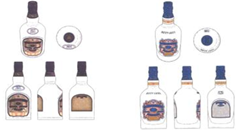The Beijing High People's Court recently granted protection to the three-dimensional (3D) bottle and device marks covering Chivas Holding (IP) Limited's Chivas Regal label and packaging and held that the accused product, which featured a decoration similar to Chivas's trademarks, constituted trademark infringement.
Facts
Chivas has registered several trademarks in China in Class 33 – namely:
- the word mark CHIVAS REGAL (Figure 1);
- two device marks for the bottle's front label and packaging (Figure 2); and
- two 3D trademarks pertaining to the bottle's shape (Figure 3).
Chivas Brothers Limited is the exclusive licensee for the above trademarks in China.
(Figure 1)

(Figure 2)

(Figure 3)
Beijing Dong Peng Ju Yuan (DPJY) Trading Co, Ltd sold a type of whisky produced by Hebei Ying Ze Long Winery Co, Ltd. The bottle reproduced Chivas's 3D trademark, but featured the name Sumai Regal (Figure 4).

(Figure 4)
On September 19 2014 Chivas and Chivas Brothers instituted a civil lawsuit against Beijing DPJY and Hebei YZL before the Beijing Number 3 Intermediate People's Court on the grounds of trademark infringement and unfair competition.
Decisions
The court compared the label, bottle shape and packaging of Sumai Regal whisky with Chivas's cited trademarks and held, in its December 23 2014 judgment, that the accused product's front label, packaging and bottle shape were similar to Chivas's marks and thus constituted trademark infringement. The court issued an injunction and granted damages of Rmb300,000.
Beijing DPJY and Hebei YZL appealed before the Beijing High People's Court. In its May 31 2017 judgment, the court upheld the first-instance court's finding of infringement, but based its decision on different reasoning.
The Beijing High People's Court held that the infringing product's most prominent mark was the word mark SUMAI REGAL and that the other signs (ie, the product's packaging and decorative pattern) were unlikely to be identified by consumers as trademarks that functioned as source identifiers. In view of this, the appellants' use of these signs on the infringing product did not constitute trademark use. However, the court opined that the designs (ie, the label, packaging and bottle shape) used by the defendant resembled Chivas's cited marks and were likely to cause confusion and misidentification among the relevant public with regard to the source of the product. The court cited Article 50.1 of the Regulations for the Implementation of the Trademark Law 2002, which provide that "using any signs which are identical with or similar to another person's registered trademark as the name of the goods or decoration of the goods on the same or similar goods, thus misleading the public" constitutes an act of 'trademark infringement', as defined in Article 52.5 of the Trademark Law as an act "to cause, in other respects, prejudice to the exclusive right of another person to use a registered trademark".
Comment
The case was adjudicated under the regime of the Trademark Law 2001 and its implementing regulations of 2002. In this legal context, the Beijing High Court's decision rectified the first-instance reasoning as the accused signs should not have been considered similar trademarks. Rather, they were a name or decoration likely to mislead the public and thus fell under the category of "causing, in other respects, prejudice etc". However, the final result was the same.
The legal background has changed under the revised law of 2013 and its implementing regulations of 2014. Article 76 of the 2014 regulations, which is the same as Article 50.1 of the 2002 regulations, refers to Article 57.2 of the revised law, which defines the act of infringement as:
"to use a trademark similar to a registered trademark in respect of the same goods or to use a trademark identical with or similar to a registered trademark in respect of similar goods, without authorization of the proprietor of the registered trademark, where such use is likely to cause confusion."
The difference between the earlier law and regulations and the later ones lies in the fact that the use of a similar name or decoration previously fell under the law's catch-all clause (ie, "to cause, in other respect prejudice etc"), whereas, under the new law, the same behaviour is explicitly considered to constitute the use of a similar trademark. As such, the discussion of whether a sign is a trademark, in the sense of a source identifier, has become obsolete.
Brand owners should strengthen their trademark portfolio by registering not only their name, but also the label, packaging and shape of their bottles as 3D trademarks.
This article was first published by the International Law Office, a premium online legal update service for major companies and law firms worldwide. Register for a free subscription.


